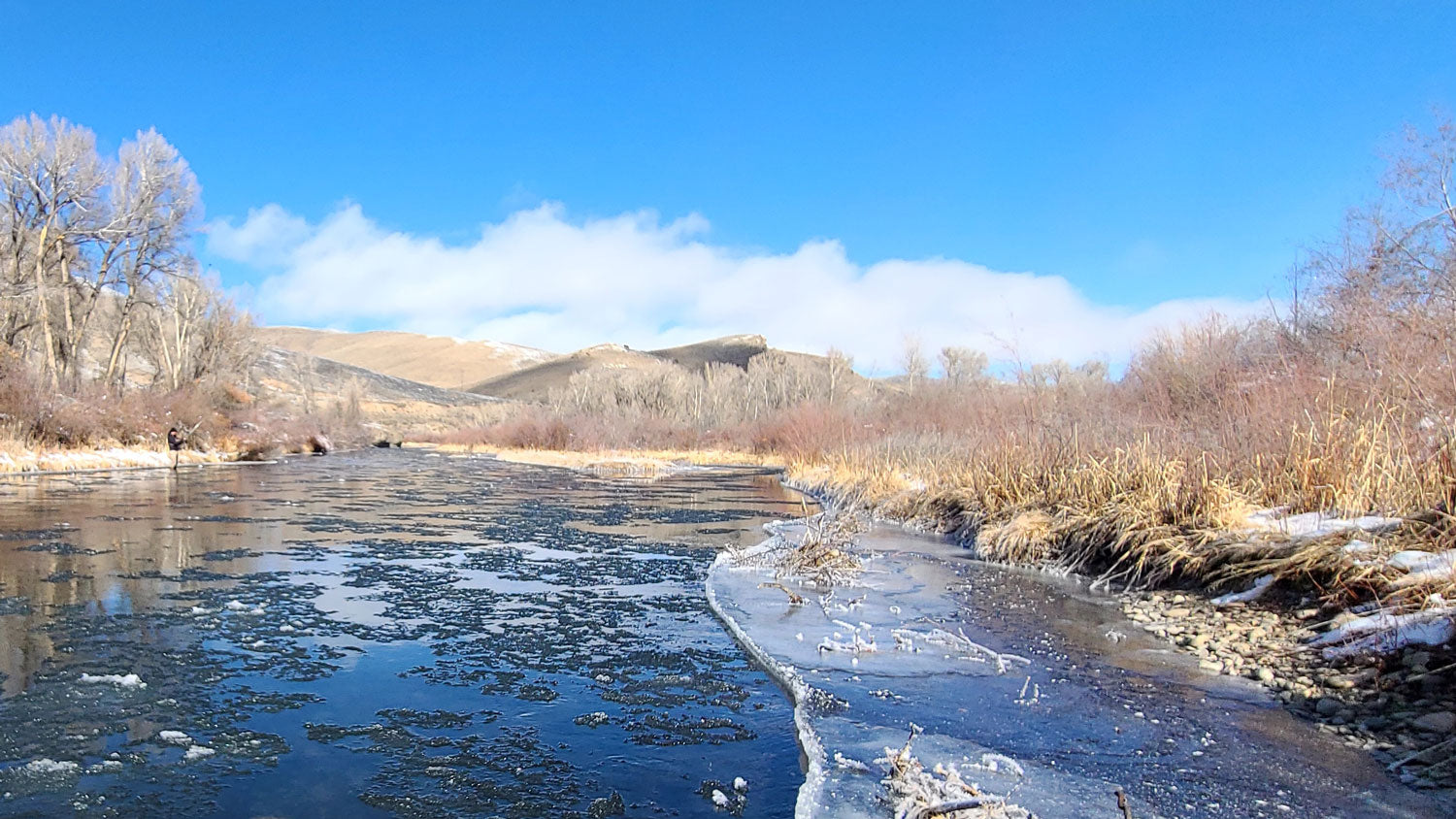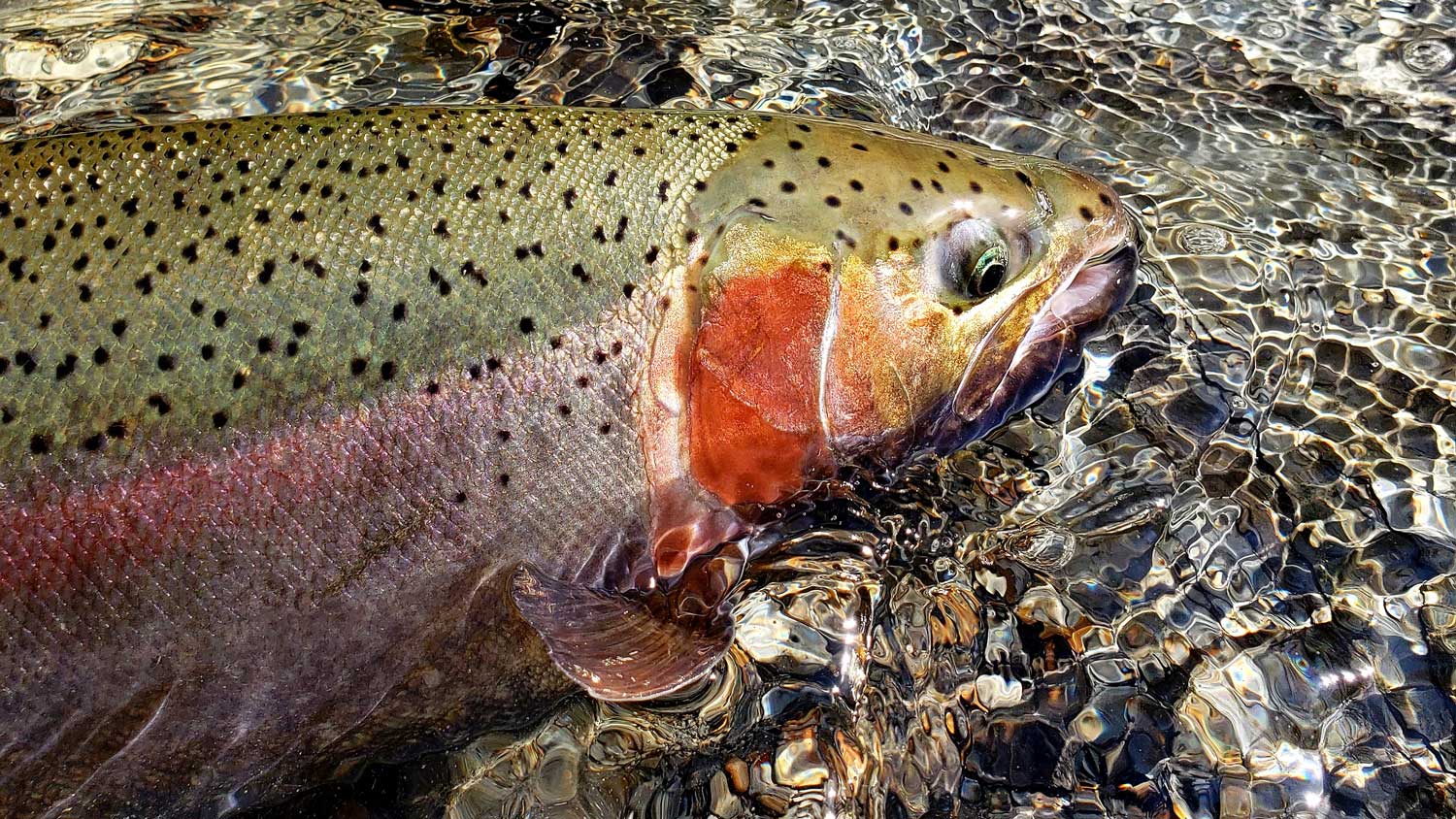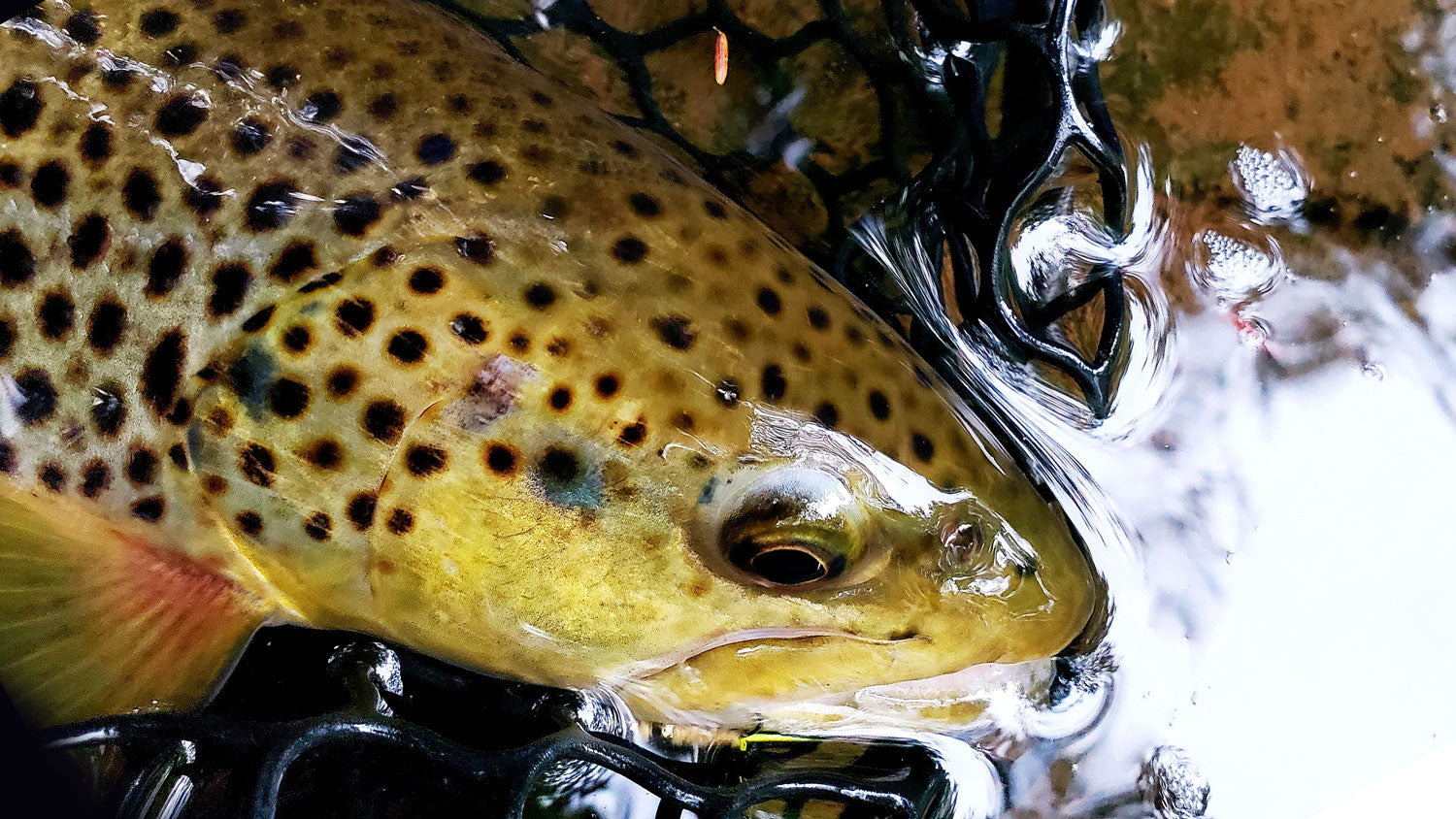Picking the right fly fishing flies for trout makes all the difference. Whether you opt for midge, stonefly, or egg and worm patterns, it's so important to choose the best fly fishing flies for February. This article will take you through fly fishing flies 101 and the best flies to use. Below is a list of the best fly fishing flies for February.
Midge Patterns
- Mercury Midge
- Crystal Midge
- Zebra Midge
- Brassy
- Disco Midge
- Flashlight Midge
- Rainbow Warrior
- Juju Bee Midge
- Rojo Midge
Stonefly Patterns
- Copper John Beadhead
- Twenty-Incher
- Kaufman Stone
Egg and Worm Patterns
- Sparkle Worm Red
- San Juan Worm
- Glo Bug Red Dot
- Nuke Egg
Midge Flies For February Fly Fishing
Mercury Midge
Midge flies are essential for trout fishing, especially in the winter, because they mimic the larvae that make up around 50% of a trout’s diet. There are a lot of different midge flies out there, but the Mercury Midge is one that everybody should have in their fly fishing flies assortment because it’s so consistent.
The Mercury Midge is a simple fly made from a small glass bead and some thread on the hook. The glass bead is the essential part of this fly because it imitates a little bubble trapped in the midge's thorax. The trout recognize this immediately, and it is particularly useful when used in conjunction with a mayfly emerger.
If you are fishing for trout in February, especially in overfished areas, the Mercury Midge is one of the best flies you can use.
Crystal Midge
The Mercury Midge is simple but effective, while the Crystal Midge has more bells and whistles. The weight is the first thing you'll notice about it, and that's down to the tungsten head. This is a deliberate design choice to help the fly sink faster, so it catches the fish's attention right away.
The pattern, which gives this fly a bit of sparkle and imitates a mosquito larva's appearance, is ideal for attracting trout in off-colored waters or fish that are particularly picky. You will get great results using this fly in rivers, streams, and spring creeks.
The Crystal Midge is another favorite for your collection, and you'll get plenty of trout in your net all year round when you use it.
Zebra Midge
The Zebra Midge is one of the most common types of midge, and you'll be very successful with a fly that imitates it. Regardless of where you are fishing, it's one of the best fly fishing flies for trout in February.
They are usually made using a chemically-sharpened carbon steel hook, tied in red, black, or olive to create one of the best examples of an imitation midge you can find.
Zebra Midge flies come in a range of sizes, and it's a good idea to get a range. In fact, people often have a separate box just for Zebra Midge flies because they're so effective.
Brassy
The Brassy fly is an excellent choice for coldwater fishing. At first glance, it looks similar to other midge flies because of the segmented body and bead head, which helps it sink very quickly.
This fly is a great starting point for anybody new to fly fishing because it's simple to tie. So, if you haven't used a midge fly before and you want to get to grips with it, try a Brassy.
There are a few variations on this fly as the traditional copper wire has been replaced by peacock herl over the years. It’s also available in red and green, with various wire colors.
Disco Midge
Off-colored water is one of the biggest challenges you face when fly fishing for trout in February. When the water is muddy and murky, you need something that will stick out and grab the fish's attention while also imitating the food that they usually eat at this time of year. The Disco Midge does both of those things very well.
Other Midge patterns are still effective, but if you are fishing murky waters and not having much luck, try a Disco Midge and see if you do any better. They are designed to imitate larva floating on the surface of the water, and although the bauble and vibrant thread will draw the trout in, they're not so bright that they scare them off. The Disco Midge is one of the best fly fishing flies for trout in muddy waters.
Flashlight Midge
If you like to fish at night, you already know that most midge flies are difficult to see at night, so that you won't get much interest from the trout. That's why the Flashlight Midge is so vital for night fishing.
The Flashlight Midge fly gives you some illumination and makes the fly more visible to the trout, so you’ll still get plenty of bites when fishing in the dark. For the best results, try casting around the banks where the trout are more likely to be searching for food at night.
No fly fishing flies assortment is complete without a Flashlight Midge fly to attract more fish at night.
Rainbow Warrior
The Rainbow Warrior is another one that everybody should have in their fly fishing flies assortment because it's a great all-rounder, especially at this time of year. The water can be unpredictable in the winter because, even though it usually is murky, runoff from the rain can make it clearer. If you only bring flies for off-colored water, they may be too bright and scare the fish.
The Rainbow Warrior, tied into the shape of a midge larva, is effective in clearer conditions as well as murky waters, making it ideal for trout fishing in February when you can't always predict the state of the water. It still stands out in murky water, but it's not too bright, so it will still be effective in clearer waters.
Juju Bee Midge
Trout struggle to find food in the winter, so they are often on the lookout for small midge larvae floating on the water's surface. At this time of year, midges often come loose from the vegetation and float along the water, where trout wait to eat them.
You can take advantage of this by using a fly that mimics a small larva on the surface of the water. However, trout in overfished areas can be suspicious of easy meals floating on the water, so you need to use a realistic fly, like the Juju Bee Midge. The lifelike feathers help it blend in, so the fish don't get scared away, but the colorful threads are still attractive.
Rojo Midge
The Rojo Midge is a lot flashier than other midge flies, but it's a great pattern that guarantees terrific results. The combination of a bright glass bead, a tuft of peacock herl, and some sparkling gold ribbing are irresistible to trout.
Anyone looking for an incredible killer dropper, you need a Rojo Midge fly in your fly box next time you head out.
Stoneflies For February Fly Fishing
Copper John
Coaxing trout out of the depths in winter waters is tough, and it requires a lot of practice and excellent technique. However, getting the right gear is vital too, and a Copper John fly pattern is one of the best options.
When the trout are hiding at the bottom of the river, they need a bit of encouragement to come up to the surface. The Copper John is a heavy fly that sinks quickly, but the small size makes it easy to move in a figure of eight to catch the trout's attention.
Although this flashy fly will help you attract more fish, you need to perfect your technique. If you continuously move it in the same way, the trout will soon catch on and get bored. But once you get the hang of it, the Copper John is one of the best fly fishing flies for trout.
Twenty-Incher
Fishing for trout in February is always a challenge because they are less active, and there isn't as much food around, so they tend to move deeper. Midge flies floating on the water can be useful, and Copper John Beadheads are great at drawing trout towards the surface. However, if you are struggling, you may need something that goes deeper.
A Twenty-Incher Stonefly is perfect for getting down in amongst the weeds where the trout are hiding at this time of year. The immense body and round head look like a delicious insect, so when it sinks and moves quickly through the water, the trout will head straight for it. In February, when there isn't much in the way of food for the fish, a Twenty-Incher works wonders.
This intermediate fly has a reputation for catching colossal trout, so if you want to up your game this February, make sure you add this to your fly box.
Kaufman Stonefly
When the trout are searching the depths of the water for food in the winter months, they're often on the lookout for big beetles. These are some of the best food sources for trout in February, which is why the Kaufman Stonefly is so effective. It mimics the beetles that trout are so desperate to find, and it's nice and heavy, so it sinks far enough to find fish in the cold months.
The design helps to attract trout in February for two reasons; firstly, it's relatively big so that it can be seen easily in murky waters. Secondly, the long legs give the impression of movement, so it looks just like a real beetle from the point of view of a trout. They won't be able to resist in the winter when they are short on food.
Worms and Egg Flies For February Fly Fishing
Sparkle Worm Red
Heavy flies that sink to the bottom are great for attracting lethargic trout's attention, but that one strategy isn't necessarily going to work all the time. Depending on the time of day, trout move around quite a lot, so you need to adjust your strategy accordingly if you want to increase your chances of success.
In the mornings, when the temperature is lower, trout usually sit around 6 feet below the water, but they will move closer to the surface in the afternoons. Throughout the day, you should try out different fly patterns at different depths to get a feel for where the trout are and what they are most attracted to.
Midge or stoneflies are both quite active, and even though they work well a lot of the time, you may want to add a Sparkle Worm to your fly box. The red color makes it look like a blood worm swimming through the water, and it has an excellent movement that will catch the eye of a trout. Although using a Sparkle Worm fly requires more patience, it's a great option to have in your arsenal when your midge or stoneflies are not working.
San Juan Worm
The San Juan Worm fly is probably the best fly for beginners that want to catch lots of trout. It's straightforward to tie, and it's got a reputation for success.
When you are fishing for trout in February, it's best to concentrate on the morning and afternoon peak times, and the San Juan Worm is a great fly. It's not dissimilar to the Sparkle Worm, but it is better suited to beginners.
It rests in the water for hours at a time, and the blood-red color catches the attention of passing trout without being too aggressive. You don't need to maintain complex movements as you would with a Copperhead John Beadhead, for example, so it's better if you are new to fly fishing. You'll have a lot of success if you sit your San Juan Worm fly in the water in the early afternoon as the temperature increases and the trout emerge to find food.
Glo Bug Red Dot
The Glo Bug fly is designed to imitate a small egg, and the little red dot is very effective at drawing in passing trout. When used well, you can catch a lot of trout with a Glo Bug fly, but it does require a higher level of skill.
It's important that you have the right gear, like waders, gloves, and a fishing vest, so you are comfortable and can focus on your technique. Surgical latex gloves are a great option because they protect your hands, but they still allow enough range of movement to control your Glo Bug fly accurately.
The eggs that fly patterns like this imitate tend to bob along in the water, and you need to replicate that movement. With the right short, sharp movements, you can trick the trout into thinking that your fly is an egg that has come loose and is floating through the water. It's a great way to draw in the trout lurking at the bottom of the water and not moving around too much.
Adding some egg flies to your fly box is an excellent way to vary your approach and boost your chances of filling your net.
Nuke Egg
When fishing for trout in cold water, it’s often best to take a two-pronged approach, targeting different depths of water. This is the most efficient way to account for the movements of trout throughout the day. Although the trout will sink to the bottom in cold water, temperature fluctuations cause them to move towards the surface. But their movements also depend on the amount of food available to them. Hungry trout are more likely to be mobile so they can find more food.
So, if you want to increase your chances of catching trout in February, you need to try a range of tactics. Use a midge or stonefly to target the area close to the surface, and then use a Nuke Egg fly to attract trout nearer the bottom, and you'll have great success.
The Nuke Egg is one of the most versatile flies because it imitates several different eggs that trout are used to eating. The colorful shroud, which looks almost transparent in the water, is unique, and it's brilliant at drawing in slow-moving trout in cold waters.
Egg flies are a useful accompaniment to midge and stoneflies, and the Nuke Egg is one of the best flies, mainly when fishing for trout in cold water.
Choosing the right fly fishing flies for trout is essential if you want to succeed in the cold months. When fishing for trout in February, it's important to remember that you need to fish deeper and that the trout move around as the temperature changes. The only way to improve your catch is to use the right fly fishing flies assortment for trout fishing in February.

Matthew Bernhardt, a third-generation Coloradan, grew up at the forefront of the state’s fly-fishing revolution, enjoying time on the water, side by side with experienced guides and lifelong anglers.
By combining his passion for fly-fishing with input from other experienced fly-fishers and guides and his fine arts degree from Colorado State University, Matthew spent five years carefully developing the Drifthook Fly Fishing System, built to help every angler catch more trout.
When he’s not spending time with his wonderful family, you’ll find him out on the water catching MONSTER trout, and he anxiously looks forward to the day when his kids are old enough to join him there.




















